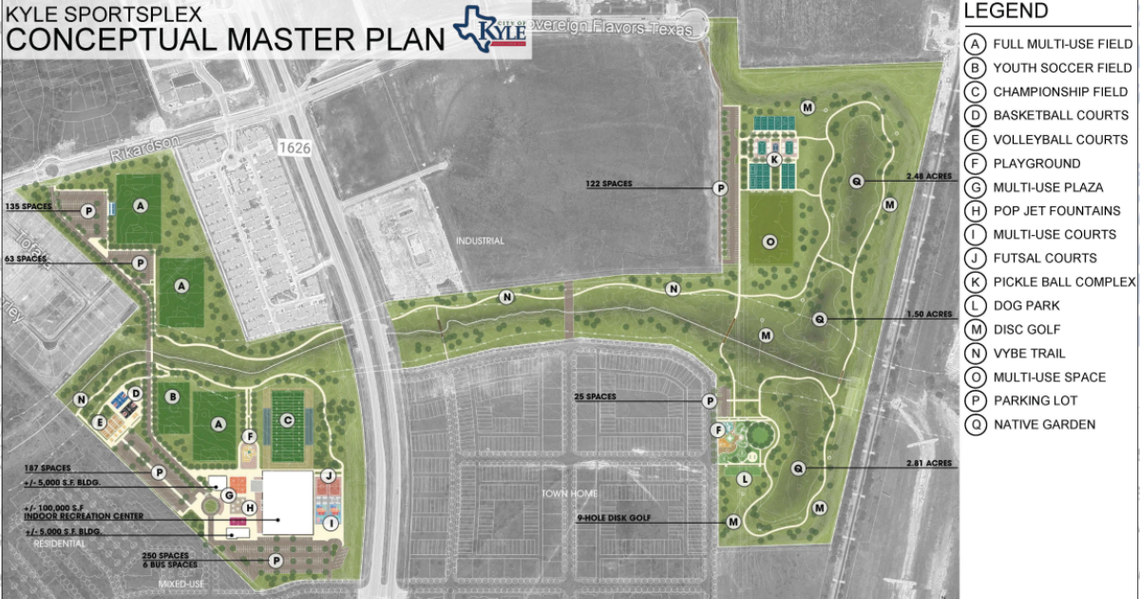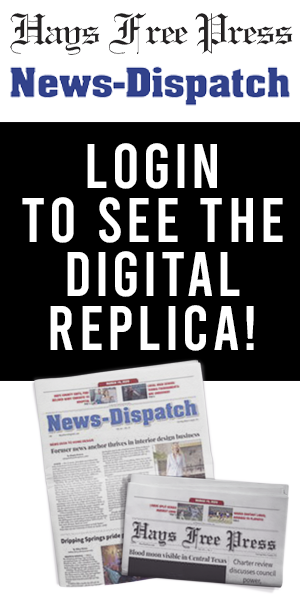KYLE — The heavily-discussed Kyle Sportsplex will be moving forward with a new $161.9 million outdoor site master plan, following approval at the July 16 Kyle City Council meeting, which was delayed a day, due to bomb threats at city hall. Additionally, residents spoke against a potential Kyle Police Department surveillance system.
According to Parks and Recreation Director David Lopez, the purpose of the master plan is “to provide site guidelines driven by community needs and input,” as 1,400 surveys revealed that residents stated that they desired more outdoor sports amenities, as well as indoor sports, fitness and recreation amenities, though they put an emphasis on it being available for strictly Kyle residents first and foremost.
Mark Maldonado of Urban Alchemy Collective then presented what Lopez described as a Kyle-centric sportsplex master plan.
“Through the involvement of the community and stakeholder feedback and a lot of discovery, we were able to come up with the project vision and project goals that really outlined what we envisioned this site and this complex to be,” Maldonado said. “The vision for the sports complex is to create a unique destination that embodies the proud and vibrant spirit of our community.”
The five goals listed were as follows:
1. A multi-purpose destination
2. Foster and connect to community
3. Enhance community amenities
4. Boost economic development
5. Strong branding and community identity
From these goals, two concepts were created. The first, “Alternative Concept A,” focused on economic development and opportunities, said Maldonado, maximizing the site for athletic uses for regional draw. This concept has numerous fields, connection to the Vybe Trail and allows room for expansion, such as a parking garage or an indoor recreation center.
The second concept, “Alternative Concept B,” puts an emphasis on community, he said, as it is nature inspired, has passive recreation, less fields, a bike trail extension and more.
These two concepts were then presented to the public, where feedback was received through two community workshops, pop-up events and more, said Maldonado, where the majority of the results were positive.
“In short, what we heard was that the city of Kyle residents want more trails, they want more playgrounds, gathering spaces and then, athletic facilities and amenities,” he shared. “ What we learned for indoor recreation was that the community wants a gym and fitness center for indoor recreation. They want indoor basketball courts, soccer fields, community rooms, programming rooms and aquatics as their top priorities.”
In addition to these desires were concerns, Maldonado stated, such as budget costs, increased traffic and taxes and maintenance and operation requirements. He noted that these will be considered when moving forward.
“Looking at the final master plan, what you start seeing here that’s presented is a blend of a little bit of Concept A, a little bit of Concept B, but also a lot more of what the community told us and guided us [with],” he said. “They wanted spaces that were nature inspired, that were environmentally conscious. They wanted trails, they wanted exercise areas, they wanted more courts and facilities, they wanted indoor recreation [and] they wanted community spaces that you don’t have to pay for that are open to the community, but they also wanted a place for families to come together and celebrate and have a sense of belonging and pride.”
The master plan is estimated to cost $161.9 million, according to agenda documents, and includes: several full multi-use fields, youth soccer field, championship field, basketball courts, volleyball courts, playgrounds, multi-use plaza, pop jet fountains, multi-use courts, futsal courts, pickle ball complex, dog park, disc golf, Vybe Trail, multi-use space, parking lot and a native garden.
Because the cost is steep, Maldonado explained that they have broken it up into five sections:
• Area 1A, which includes the championship field, youth soccer field, a multi-use field, basketball courts, volleyball courts, a playground and a parking lot, is estimated at $30.6 million.
• Area 1B, which includes the other two multi-use fields and parking, is $11.2 million.
• Area 2 for $88.6 million includes the multi-use plaza, pop jet fountains, multi-use courts, futsal courts and a parking lot.
• Area 3 is the majority of the Vybe Trail and is estimated at $12 million.
• Area 4, which includes a playground, pickle ball complex, dog park, disc golf, multi-use space, the native garden and a parking lot, is $19.2 million.
The second area also includes space for a 100,000 square foot indoor recreation center, of which 73% of the community stated was a priority, Maldonado said.
“At the time, we didn’t ask any more questions beyond that,” he explained. “That should come at a later phase, but for these purposes of this master plan, for now, we just have a potential space.”
Finishing his presentation, Maldonado stated that council could adopt the master plan and later approve an outdoor recreation design contract that focuses on elements that already have funding, most likely Area 1A or Area 1B.
Council member Lauralee Harris began the discussion, noting that there was a lack of softball and baseball fields in the concepts, to which Lopez replied that other conceptual and master planning designs are underway that would fill this gap.
Praising the master plan was council member Bear Heiser, who stated that a great job was done and further emphasized that the city needs more sports infrastructure: “I hear from people all the time who complain about having to drive a long way [for sports] … Bringing sports back to Kyle is going to make a big impact.”
“I’m looking at the local level. I’m looking at allowing everyone to come in and use this from our community. I’m thinking about those kids [whose] parents can’t really afford the big sports leagues, can’t afford all the other stuff. I want to make sure those kids, [that] as a city, we’re going to bring in programming that’s going to allow these kids to come in,” said council member Robert Rizo.
Mayor Travis Mitchell continued with a similar sentiment, stating that the city is failing its children by “not having a vision for sports infrastructure.”
Rizo also commented on the amount of engagement done, stating that he saw the team out at Kyle Market Days doing “everything but grab people off the street.”
Turning the conversation toward staffing was council member Michael Tobias, who observed that the complex is massive. Not only that, but he is concerned about the necessary infrastructure, such as roads and potentially the need for more hotels if they want to bring grand tournaments to the facility, as well.
Heiser responded, stating that the sportsplex “is very much a phased approach,” a long-term vision, so there is time for all of the required infrastructure to be considered.
“In the end, the people see just the bottom dollar. So, when you’re adding up the field, you’re adding up this, $30 million here, $2 million here, $4 million there, $3 million there — it all comes down to like, ‘Holy geez, we got $161 million for this whole area. How are we going to pay for all this,’” asked Tobias.
Then, Tobias stated that creating partnerships would place the decision making in a third-party’s hands, such as what teams will be there, what sports, what pricing and more.
“I know this is a concept design, but I think the city also has to look at, ‘Okay, well, where are we pulling the economic funding from? Because in the end, you will leave out the locals because they will be stuck with traffic. They will be stuck with long lines at restaurants. They will be stuck on a waiting list to be able to just go play basketball because you’ve got a tournament that has paid the fees to use those sports fields,” stressed Tobias.
Rizo stated that this scenario would be up to the residents to decide in the future, as the funding would come from them. Additionally, these are all future plans, he said, not ongoing plans, as the first phases put the residents as priority.
“This project must go forward with both a public amenity use that is designed for the locals and good select leagues or partners that will help to generate revenue to take some of that burden off. Both of those things have to happen simultaneously in order for this project to succeed,” said Mitchell.
For example, he shared that there have been meetings with Texas State University, which has expressed interest in a potential partnership.
According to city manager Bryan Langley, the master plan has been put together to determine where to put assets and why, so the construction would be organized. It would begin with the $33 million that has been identified for the first phase, $14 million of which comes from voter-approved bonds in 2020. The remaining amount of money is from Tax Increment Reinvestment Zones and allocation from other funds.
The item to approve the $161.9 million outdoor site master plan for the regional sportsplex was approved unanimously.
Additionally, council approved a resolution authorizing the city and KPD to apply, receive and use funds from a grant to purchase a mobile video surveillance tower system in an amount to not exceed $50,000.
According to agenda documents, the grant is provided by the Community Development Partnership Program through the Lower Colorado River Authority.
KPD Chief Jeff Barnett stated that the Kyle Office of Emergency Management, a division of KPD, is requesting to apply for the grant, as it would support the purchase of a portable trailer system, with a telescopic pole mounted camera system. These systems are typically seen in shopping center parking lots and construction sites, as they “serve as effective tools for deterring criminal activity,” said Barnett. The department's goal would be to use the system at large community events, such as the city fair, concerts and holiday celebrations, to enhance public safety by enabling real-time monitoring.
For example, the chief shared that one of these were already used at the Kyle Fair, as KPD received an offer to test equipment from a company, which was perfect timing, as the organization was looking into the product and what it could do. It provided a sense of safety, he continued, and allowed KPD to monitor crowd movement, where possible issues could arise, traffic movement and whether there were any emergencies occurring.
Barnett emphasized that these cameras are not equipped with license plate readers, facial recognition software or other invasive surveillance technologies in response to several public comments, which stated that these mobile surveillance towers provide an interruption of privacy.
Resident Claudia Zapata, who spoke during public comment, stated that “I would guess that most residents in this room have no idea that between Austin and San Antonio, they live in the most surveilled city in Central Texas. Item 16, which proposes buying a mobile surveillance tower, fits a larger pattern of unfettered surveillance expansion … This item lacks any transparency. No vendor is named, no product description, no proposed policies for how the surveillance tower would be used. No information on how the data would be stored, shared or deleted.”
The surveillance company Flock, which Kyle already utilizes services from, was mentioned several times from residents, but Barnett emphasized that, at this time, no specific brands have been considered.
“I just want to make sure, when we apply for this grant, that if it does pass through, that a policy would be in place [regarding the technology usage],” said Tobias. “[When] we also finally select a vendor, [we need] to really dissect them to the tee to see what technology they have.”
Rizo stated that he understood comments made as this is a tense and difficult time in the world, but that he also sees the positive impact that it could have. So, he agreed with Tobias, stating that there needs to be research done to ensure there wouldn’t be overly advanced technology, including facial recognition.
“If you give us permission for us to apply for the grant, to go along with all of the council members interest, we could certainly bring it back for your final approval and when we do that, you would see the full scope of the equipment, the vendor that we selected and every option that it offers and what it does not offer. Then, secondly, we could bring back a policy that addresses all of these concerns that you mentioned because we’re on the same page with you and we understand these concerns, as well,” said Barnett. “We don’t want the community to fear law enforcement. We just think this would be an added tool to help us keep our community safe.”
The item was approved 5-2, with Heiser and council member Miguel Zuniga dissenting.
To listen to the discussions, visit bit.ly/4lHTPyn.










